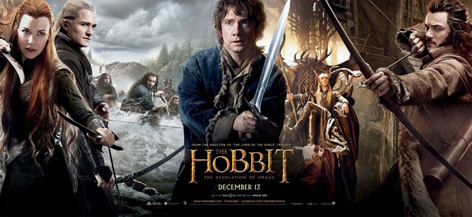Movie Review - The Hobbit: The Desolation of Smaug
By Matthew Huntley
December 19, 2013
The second installment of The Hobbit trilogy is subtitled “The Desolation of Smaug,” referring to the devastation wreaked by the evil yet insidious Dragon in J.R.R. Tolkien’s Middle Earth. However, the “desolation” part of the title isn’t as apt as you might think (or even hoped), because the effects of Smaug aren’t as deeply felt by the audience as they should be, which should give you an idea of why the movie never takes off.
In my review of The Hobbit: An Unexpected Journey, I made a point of saying it was the first of the modern Middle Earth adaptations (the others obviously being The Lord of the Rings trilogy) to have a protagonist at its heart with whom we could identify and get behind. That would be Bilbo Baggins (Martin Freeman), the titular hobbit who was sought after by a group of dwarves to accompany them on a journey to Lonely Mountain so they could reclaim their homeland from Smaug, who now sleeps inside under mounds of gold and other jewels.
Bilbo displayed a humility and humanity (despite being a hobbit) that made us care about and relate to his fears, anxieties and uncertainties. But our empathy toward him, not to mention the other characters, is all but lost this time around. The movie sacrifices it in favor of perfunctory action sequences, to which it jumps one after the other as we sit by rather passively. With its plethora of special effects and stunts, there’s always something to look at, but there’s not always something to watch, if you know what I mean.
Amidst the non-stop fight scenes, chase sequences and character banter, we find ourselves asking, why do we care about any of this? At this point in the saga, we should be much more invested, and the title of the movie suggests that investment should stem from the havoc inflicted by Smaug on the cities of Erebor and Dale. But we’re not, and instead of leaving the movie excited, fearful, or giddy with anticipation for the upcoming conclusion, we’re apathetic.
It’s funny, but while watching “Smaug,” I was reminded of the World War II mini-series, Band of Brothers, and its key episode titled, “Why We Fight,” which made it clear why the American soldiers’ mission was essential. I didn’t get that feeling with Bilbo and company. Not that Band of Brothers and The Hobbit are necessarily comparable, but the point is this movie lacks an emotional hook and thus makes it difficult for us to rationalize why this journey is so important. Perhaps too much time was dedicated to the action, style and presentation when the focus should have been the characters and their cause.
The story, which has needlessly been spread out over three two-and-a-half-hour-plus movies (Tolkien’s 300-page novel has been overly padded with extraneous characters and subplots), picks up where the first one left off. Bilbo and the 13 elves, led by Thorin (Richard Armitage), are making their way to Lonely Mountain to confront Smaug and take back their homeland. At the same time, they’re being pursued by monstrous, ugly orcs but receive aid from a skin changer named Beorn (Mikael Persbrandt), who sometimes takes the shape of a larger-than-life bear. He provides the group sustenance and horses so they can make their way to the ominous Mirkwood Forest, where they do battle with giant spiders and elves. Lucky for Bilbo, he has his trusted ring, which gives him the power of invisibility, but little does he know about the detrimental effects it’s taking on his self-control.
Continued:
1
2




